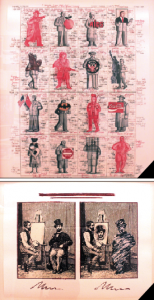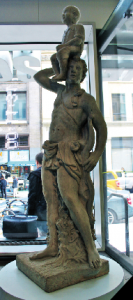Art History Flavors The New School’s Halls
Through the haze of smoke in the Lang courtyard, where students roll cigarettes, click through Tumblr or occasionally glaze over their homework, a sculpture by Martin Puryear, an internationally renowned artist, sits unrecognized. Students sit on the three large rounded chairs made of wood, granite and metal in the 12th Street atrium and Vera List Courtyard every day, but the chairs are rarely appreciated as works of art.
In every New School building, students pass such priceless works as Sol Lewitt murals, Roy Lichtenstein silkscreens and Andy Warhol prints as they rush to class. The 2,000 sculptures, prints, paintings and murals that make up the New School Permanent Art Collection are one of the university’s best kept secrets, hidden in plain sight.
In college life’s organized chaos, The New School’s Art Collection is often overlooked. Many students go through their entire degree at The New School without ever fully taking in the Orozco mural, one of the most topical Mexican frescos of its time, as it is primarily in an (often locked) room on the 7th floor of 12th Street that used to be the cafeteria but is now a meeting area and on occasion, a classroom.

Instead, artwork is on display throughout every hall. Whether this is through the more permanent pieces such as the site-specific commissions and murals which show our university’s background in social justice or the pieces which shift and eventually leave the collection serving as contemporary representations of the present day, the collection does nothing less than provide a portal into the past, present and future of The New School.
If asked “Where exactly is The New School Art Collection?,” Silvia Rocciolo said she would respond, “It’s around you.” On tours, Rocciolo is engaging and animated. She grins as she looks on Berenice Abbott’s dowdy visage in a photograph on the 7th floor of 12th Street while describing the extent of the collection. Walking through Tishman Auditorium, she sweeps her arms widely, mimicking the curvaceous architecture. Later, her brow furrows as she talks about legal battles. Her passion for the art collection is endless. Rocciolo is one-half of the curating duo for The New School’s Permanent Art Collection. Her job for the past seven years, along with co-worker Eric Stark and a small team of students and curatorial assistants, involves the care and restoration of the thousands of works of art that comprise the collection.
Unlike art acquisitions at other universities, The New School’s collection does not hide in an underground vault, in a sanitized white room, or even in a single building. Instead artwork is on display throughout the school’s 15 buildings. Students and faculty interact with the art everyday, even if it’s just a quick glance on the way to the bathroom. Al Souza polaroids, Norman Rockwell collotypes and Robert Mapplethorpe prints hang across from informational flyers for study abroad programs and intramural sports teams.
“The art collection was created so that the community, students, professors and faculty live with the work,” said Rocciolo.
Beginning in 1960, Vera and Albert List funded or donated about 500 of the 2,000 artworks in the collection. The philanthropists gave the school $50,000 to spend exclusively on artworks. The Lists were well known for their donations to the arts by contributing to funding the construction of the Lincoln Center and helping establish the New Museum of Contemporary Art in SoHo.
“When Vera List proclaimed that art was connected to life, it made sense that the works in the collection would therefore reflect topics in the life of our society,” said Carin Kuoni of the Vera List Center.
Rocciolo often begins her tours of the art collection in Tishman Auditorium. During the Great Depression, then-president Alvin Johnson purchased land on E. 12th Street to accommodate the growing number of students at The New School. Johnson chose Joseph Urban, an architect, artist and set designer, to create a structure that would reflect The New School’s modernist ethos. The design of the auditorium’s curving eggshell shape and low stage allowed those speaking to feel calmer and to make the audience, whether large or small, seem less intimidating.
Beneath Tishman is the first circular dance studio in the U.S., across from which was once a massive Camilo Egas mural. Johnson commissioned Egas, along with Thomas Hart Benton and Jose Clement Orozco, to create three site-specific murals for The New School. Along with Tishman Auditorium, now a New York City landmark, the three murals were the true beginning of the New School Art Collection.
“It differs from a big museum where there is a more specific standard of the types of art and artists that are shown,” said Julia Foulkes, an associate professor and Chair of Social Sciences at The New School for Public Engagement. “There is much more variety in The New School collection, and there are artists and pieces that would likely not be found in a big museum.”
This variety stems from Vera List’s goal for the art collection to be constantly evolving, trading out older purchases for newer commissions by upcoming artists.
When placing a piece, Rocciolo and Stark install works in specific locations in order to stimulate a particular community. They plan out where to place works based on departments, offices and types of student interactions in certain areas of the school.
Occasionally, conflict arises about a piece. “We see it as an opportunity to explore the conflict through dialogue,” says Rocciolo. “Most of the time, when we dig deeper and get to the core of the artist’s intention, everyone ends up learning something new, a different point of view, an unexpected way to read the world.”
During the McCarthy era of the 1950s, The New School administration decided to cover part of the Orozco mural with a yellow curtain because it depicted Lenin and Stalin. The move was debated feverishly by both students and faculty. The curtain was eventually taken down.
In the 12th Street building, anyone interested can lead themselves on their own tour of the art collection. Starting on the 9th floor, you can work your way down, collecting printouts displayed by the elevators. Each floor follows a different theme, including pop art, minimalism, and sculptor’s drawings. On the 7th floor, alongside the Orozco murals, are photos by Berenice Abbott who taught some of the first college photography classes ever offered at The New School.

(Henry Miller)
The curators are constantly working to expand the collection and to get students more involved. Professors collaborate with Rocciolo and Stark to use the collection in classes. For instance, the Orozco murals are often included in the coursework for social justice classes at both Parsons and Lang. Rocciolo and Stark are also working to digitize the collection to increase student access and allow them to use the database for school projects.
As a historian, Foulkes supports the curators’ mission to widen access to the collection. “It’s kind of cool to just live with it, but if we can point it out and make students see something differently, that’s great.”
The New School’s Art Collection may often go unnoticed by those who work and learn alongside it, but the collection itself serves as a mirror. It shows humanity’s mistakes and triumphs, spans centuries, artistic movements and language barriers. The collection is a part of the history of both The New School and the world, and it would serve students well to take a moment, a glance and maybe even a tour.
With reporting by Sterling King








Wonderful blog! I found it while searching on Yahoo News.
Do you have any tips on how to get listed in Yahoo News?
I’ve been trying for a while but I never seem to get there!
Many thanks
Hello very nice web site!! Guy .. Beautiful .. Superb ..
I will bookmark your web site and take the feeds also?
I’m satisfied to seek out so many useful information right here in the put up, we’d like develop more strategies in this regard,
thank you for sharing. . . . . .